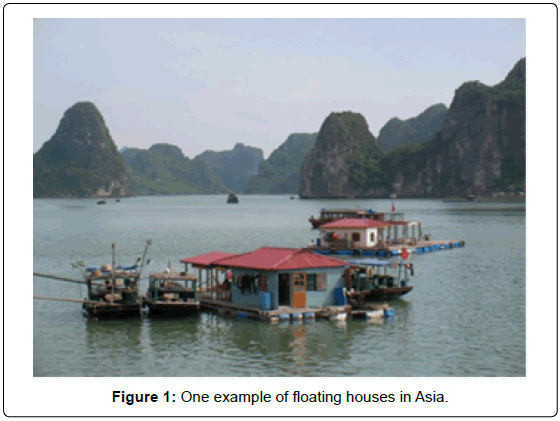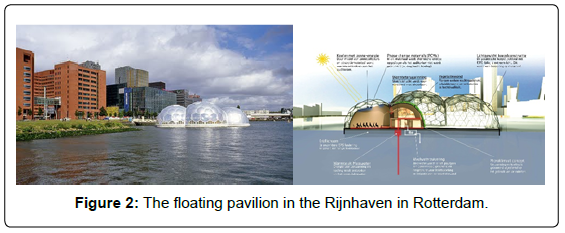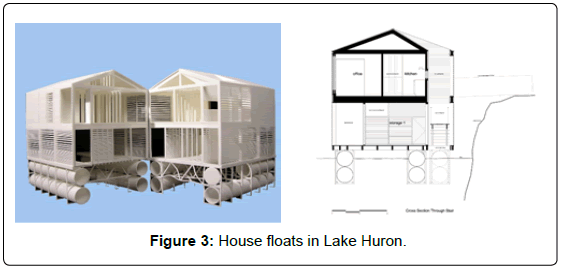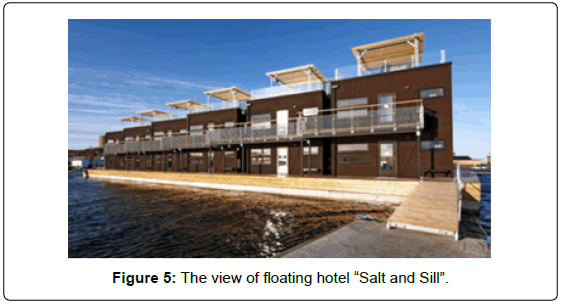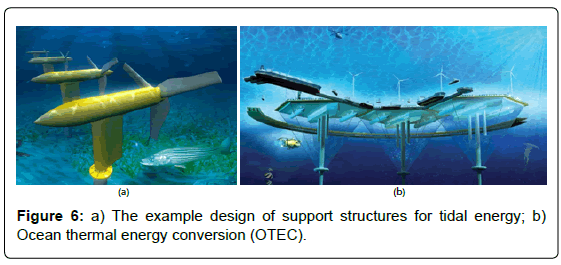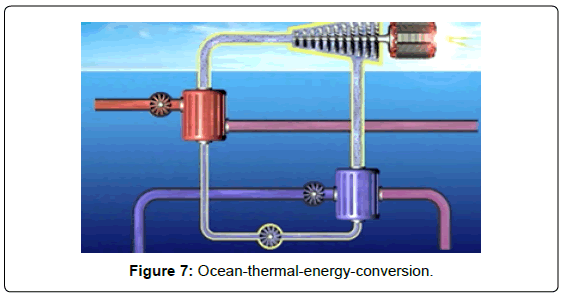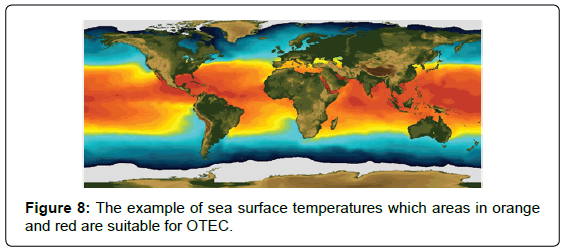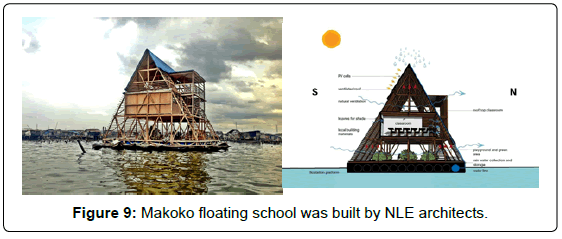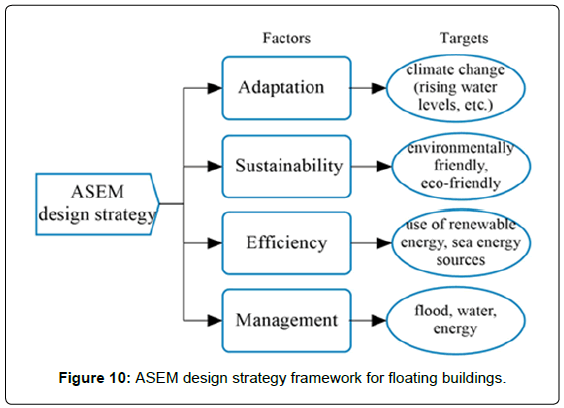Research Article Open Access
Floating Building Opportunities for Future Sustainable Development and Energy Efficiency Gains
Shahryar Habibi*
Faculty of Architecture, University of Ferrara, Via Quartieri 8 44100 Ferrara, Italy
- *Corresponding Author:
- Shahryar Habibi
PhD Candidate, Faculty of Architecture
University of Ferrara, Via
Quartieri 8 44100 Ferrara, Italy
Tel: +393886474741
E-mail: hbbshr@unife.it
Received Date: April 28, 2015 Accepted Date: May 18, 2015 Published Date: May 29, 2015
Citation: Habibi S (2015) Floating Building Opportunities for Future Sustainable Development and Energy Efficiency Gains. J Archit Eng Tech 4:142. doi:10.4172/2168-9717.1000142
Copyright: © 2015 Habibi S. This is an open-access article distributed under the terms of the Creative Commons Attribution License, which permits unrestricted use, distribution, and reproduction in any medium, provided the original author and source are credited.
Visit for more related articles at Journal of Architectural Engineering Technology
Abstract
This paper presents the study concerning floating buildings in terms of energy efficiency performance and improving awareness to build them. It includes their capacity to deal with climate change by leading the use and implementation of innovative technologies in the built environment. Comparing floating buildings with land-based buildings reveals several advantages including the use of renewable energy sources and embarks on developing new settlement planning. This paper presents a review of the principal features of floating buildings that have a direct impact on global energy supplies and alternative renewable energy sources. Development of floating buildings needs the implementation of new technology, social and community knowledge. The new knowledge and experience gained in floating buildings can lead to optimum future approaches. This paper presents guidelines for developing sustainability strategies or decision-making frameworks for offshore renewable energy facilities. It will analyze example projects built on the seas in relation to offshore wind energy, wave energy and photovoltaic cells. The development and assessment of sea energy sources should be considered as renewable energy source. It also provides new strategies and methods to reduce climate crisis regarding floating architecture and promoting offshore energies as renewable energy resources. This paper highlights the importance of relevance to floating buildings as strategies for adapting to climate change and clarifies that offshore renewable energy resource should be focused in the study of future sustainable development and energy efficiency targets.
Keywords
Floating buildings; Energy efficiency; Built environment; Renewable energies
Introduction
As it is known environmental issues such as rapid growth of human population, depletion of the energy sources, global warming and increasing water level have affected the ecosystems and biological diversity which need to be considered with sustainable design strategies and innovative solutions. The efficient use of energy in buildings requires understanding a series of questions and issues in relation to the built environment and also seeks new concepts and forwardlooking visions. Energy consumption has environmental impacts and plays a key role in addressing challenges of assessment in the built environment. Non-renewable energy sources are being consumed at staggering rates which can lead to major environmental challenges and concerns.
Due to environmental and energy-related concerns, the architectural community needs to consider these issues and associated risks. The concept of floating architecture can be introduced as an innovative solution to climate change challenges in the built environment rather than hypothesis. Not only does floating architecture can create new architecture style but also connect an interface between the offshore renewable energy and the built environment. The idea of living and working on water itself is neither new nor innovative. In fact, there are many instances of floating buildings in the Sumerian period which were built by the Madan people in the swamps of Mesopotamia. Figure 1 [1] shows an example of floating houses in Asia which has a much longer history of floating architecture, in which people are still living.
There are major categories of design methodologies for floating buildings. In order to implement appropriate methods and techniques in design process for developing floating buildings, hydrothermal use of water and mechanical and thermal properties of materials should be taken into consideration prior to other factors. For example, due to temperature difference between the water and the outdoor air, hydrothermal use of the water can play a significant role in providing energy source which can be used both for cooling and heating. Therefore, the main infrastructures to maximize the use of water should be provided before establishing a new project. Material selection is another main step in the process of designing any floating building. Although, materials selected should be suitable for use with marine environment, there are different types of innovative materials which can be considered as highly appropriate for floating buildings. For example, titanium and its alloy have been widely used as an excellent structural material in many fields because of their high specific strength and superior corrosion resistance [2]. However, Ti alloys exhibit relatively poor wear resistance, which is due to their low surface micro-hardness [3,4]. A new study by Ye [5], shows that the effect of electro pulsing ultrasonic shock (EUS) on the micro hardness and microstructure of Ti improved the micro hardness dramatically, compared with the only ultrasonic-shocked sample. Titanium and its alloys, especially dual phase titanium alloys Ti–6Al–4V, are the most attractive metallic materials used in dentistry and other biomedical field due to their outstanding biocompatibility, light weight, good corrosion resistance and high strength/weight ratio [6]. So, an investigation into innovative materials and methods can be led to find new opportunities for floating buildings.
Sustainability
Sustainable design is one of the most important factors in the building and planning process. Sustainable construction has emerged as a guiding paradigm to create a new kind of built environment: one that meets the needs of humans in the present without limiting the ability of future generations to meet their own needs [7]. Climate change and energy consumption have a significant impact on the sustainability. The first step in identifying and addressing environmental sustainability issues is to explore new concepts for renewable energy sources. Floating building design refers to many possibilities for energy efficiency and renewable energy technologies. For instance, offshore wind energy, wave energy and photovoltaic cells on the sea can be used to provide new renewable energy source for the future and reduce dependence on other resources. Creating a floating environment will not only provide a number of important benefits, but also influence people’s lifestyles. It is clear that building a floating house has the disadvantages including issues with accessibility-based transportation and threats to the marine environment, but a series of environmental solutions have great potential for solving these problems. Sustainable architecture is a general term that describes environmentally conscious design techniques in architecture. It is framed by the larger discussion of sustainability, the pressing economic and political issues of our world. In the broad context, sustainable architecture seeks to minimize the negative environmental impact of buildings by enhancing efficiency and moderation in the use of materials, energy, and development space. Most simply, the idea of sustainability or ecological design is to ensure that our actions and decisions today do not inhibit the opportunities of future generations. This term describes an energy and ecologically conscious approach to the design of the built environment [8].
To create a sustainable future vision, there are certain demands that need to be met. As already said, it must be a sustainable solution. To ensure that the goals are reached, it seems logical the solution should have a hybrid character. The combination of different solutions gives more chance for success since one solution can work out better than the other. Flexibility is needed for somewhat the same reason. The solution that is given must work under various conditions to be feasible [9].
Developing sustainable construction strategies should be considered to build floating buildings through new and innovative architecture concepts. Floating building constructions offer great opportunities for producing more cost-effective and energy efficiency solutions in terms of environmental complexity. They are varying from a compact core to more dispersed configuration so that they can be constructed on an industrial scale under controlled conditions. Floating building construction concepts can provide unprecedented opportunities for carrying out energy efficiency innovation and improving building energy efficiency beyond minimum requirements. They bring about chances of successfully introducing new concepts like cradle to cradle in the building world. The sustainability of floating buildings should be proportional and compatible with the natural habitat of wildlife in the sea. Meanwhile, according to the British Columbia Float Home Standards, floating building means a structure incorporating a floatation system, intended for use or being used or occupied for residential purposes, containing one dwelling unit only, not primarily intended for, or usable in navigation and does not include a water craft designed or intended for navigation [10]. Therefore, sustainability of floating architecture can be interpreted as an energy and ecologically conscious approach to a building for living/working space on floatation system without navigation tool [11].
Environmental design process in floating buildings
The development of the sustainable strategy in construction highlights the important role of sustainability to achieve efficiency and higher-quality performance in the buildings. In order to achieve sustainable development by promoting floating buildings, it is necessary that the analysis and design of floating buildings to be considered in relation to environmental sustainability indicators. Development of design criteria for floating buildings (not intended for navigational use) should also include a series of guidelines and frameworks such as global and environmental issues related to water, and understanding emotional and psychological aspects of living in floating buildings. Floating buildings can provide the concepts of sustainable design in architecture that are summarized as follows: promoting renewable energy generation, accessibility, reuse, recycling and self-supporting. To create a sustainable floating building, it needs to take key design points into consideration. But, there is not any prominent standard related to design it. For example, Queensland Development Code 2006 [12] is only reference that provides recommendations and design criteria for permanently moored floating buildings. According to the mentioned guideline, the main principles and concepts of environmental design process in floating buildings are as follows:
1) Access: A floating building must have adequate means of access to and from the shore appropriate to the likely number of people accommodated in the floating building.
2) Flotation system: A floating building must have a floatation system which maintains an acceptable level of stability appropriate to the use or likely use of the building and which will not be affected by minor impact; and is capable of withstanding the most adverse combination of loads it is likely to be exposed to.
3) Mooring piles: Mooring piles must be designed to adequately and safely resist all lateral loads resulting from the most adverse combination of loads which are likely to act on the flotation system and superstructure of the floating building and any vessel attached to the floating building or mooring piles.
4) Materials (generally): All materials used in a floating building or any structure associated with a floating building must be suitable for the conditions to which they are exposed.
5) Materials (fastenings): All fastenings used in a floating building or any structure associated with a floating building, must be appropriate for the conditions to which they are exposed taking into account their ability to be maintained or replaced if necessary.
6) Location: The location of a floating building must maintain an acceptable level of amenity between any other building and any proposed building.
7) Safety equipment: Floating building must have appropriate life safety devices suitable for marine use.
8) Firefighting equipment: Floating building must have access to appropriate levels firefighting equipment to safeguard against fire spread.
9) Minimum water depth: Water depth under a floating building must at all times be sufficient to prevent grounding of the building [12].
The development of floating building concepts for solving environmental issues should include a series of considerations such as waste management systems, durability of materials and accessibility. Therefore, environmental performance assessments of floating buildings can play a key role in forming and planning of floating offshore bases. There are many factors that should also be considered for design process methods in the floating architecture that can be summarized in the following steps:
• Long-term lifecycle
• Long-term GHG emissions
• Resource usage strategies
• Minimal environmental impacts
• Recycled and recyclable.
Methodologies and Sea Energy Resource Assessments
As mentioned above, design criteria of floating buildings are focused on a series of environmental issues and architectural design challenges. Furthermore, environmental aspects of floating buildings have led to the development of sea renewable energies which are emerging as new source of energies. Therefore, it is necessary to focus simultaneously on the potential environmental impacts of floating buildings related to renewable energy including large district energy systems (e.g. offshore wind turbines) and architectural design process. To develop these aims and meet the sustainability goals, the relationship among floating buildings and implications of sea renewable energies for energy efficiency should be determined based on their relevance and significance and new criteria. It is clear that development of floating buildings needs more comprehensive approaches to address technical challenges which should be taken into consideration, but in spite of all these requirements, floating buildings can be considered as the major opportunities for climate change mitigation plans and energy efficiency approaches. Although in the context of floating structures many of the studies are current based on these aspects, sustainability benefits and advantages of floating buildings are still unknown.. Therefore, architects and designer should be involved in all phases from evaluating floating buildings in terms of sustainability indicators to understanding their potential effects and energy supply. For instance, in the Rijnhaven in Rotterdam, the floating pavilion is remarkable not only because of the spheres floating on the water, but also because of its climate-proof, innovative, sustainable and flexible qualities. The floating pavilion is a pilot and a catalyst for floating construction in Rotterdam (Figure 2).
The level of sustainability of the pavilion is determined by the materials used, its flexibility, as well as its fittings. For instance, the building’s heating and air conditioning systems rely on solar energy and surface water. It contains various climatic zones; the energy is used only in places where it is required at any specific moment. Where power is concerned, the pavilion will largely be self-sufficient. The pavilion even purifies its own toilet water. Whatever is left, can subsequently be discharged into the surface water [13].
Sustainable practices through innovative architecture including concepts, methodologies, tools, applications and passive design strategies are quickly becoming the catchphrases of the architectural community. Advocating environmentally-friendly technologies and innovative research methodologies highlight accurate paths for architecture and the built environment. As building on solid ground may not always be the conventional practice, therefore, design community is required to create facilities that are environmentally accountable through new concepts and strategies. To illustrate the potential applications of floating buildings, it can be referred to many examples of floating buildings that have been built in recent years. For instance, the floating houses in Lake Huron [14] have been designed with regard to significant water level variations caused by annual climate change. Therefore, to adapt to existing conditions, structure of steel pontoons are used to allow houses to fluctuate along with the lake (Figure 3).
As can be deduced from the above-mentioned project initiatives, along with an architectural style, a number of solutions for the environmental problems have been successfully adopted and implemented. Although, in the recent projects, offshore energy potentials have not been taken entirely into consideration, there are few projects that have focused on offshore energy supply. In recent engineering practice in relation to floating buildings more innovative investigation methods have been developed for floating structures. They are classified based on their shape, mobility, and function. Figure 4 shows various concepts of floating structure proposed for construction. It includes two types such as floating bridge and floating home that are being used recently.
Floating structures can be realized on an open water surface. The structures can move along with the water level. This way any water height is possible, so the buildings are not at the expense of water storage. The floating buildings can be permanent in water, but when the floating body and soil underneath is made suitable, the floating building can also rest on the ground when the water is low or when there is no water at all [15].
Floating buildings can play a role in providing sustainable energy future and renewable energy sources. Important objectives of floating buildings also include ways to reduce energy consumption and CO2 emissions in the built environment. Offshore energy sources have potential advantages that have been given less attention and should be considered as one of the objectives of floating buildings to provide new sources of them.
Wave energy as one of the main energy sources has the potential to address the development of effective energy efficiency policies over other renewable energy sources. For example, wave conversion can occur all hours of the day; therefore, when electrical energy usage is low during the nighttime “wave energy can be used for economically powering desalinization and hydrogen production” (OPT). Sea wave energy conversion can provide renewable energy for coastal cities and communities, but can also generate a new building typology [16]. To illustrate this point, the design of floating hotel "Salt and Sill in Sweden was done with the environment sustainability concept such as heating energy for the building which is actually generated by geothermal wheels from underneath the building, at the bottom of the sea (Figure 5) [17].
Sea energy and floating buildings
Wave energy and sea power technologies are new environmental power generation, cost-effective and efficient compared to other energy sources. Recent global energy problems have caused concerns about finding solutions in relation to sustainable and most efficient alternative energy sources. For instance, sea energy includes largest untapped and abundant source of renewable energy. The initial design phase of floating buildings along with architectural design projects can produce environmentally friendly energies from oceans and seas. Although, nowadays the use of these resources are growing, merging them with floating buildings can be acquired a massive transformation in the energy and architecture. Floating building as a potential design can be equipped with sea energy resources and make it entirely self–supporting, self-sufficient and self-sustaining. Currently many marine-based renewable energy sources are in development, but other renewable sources such as the sea wave energies are still fairly unknown to sustainability research. Sustainable features of the floating buildings from an energy point of view can also be considered as efficient and cost-effective ways to reduce CO2 emission.
According to Paula Berinstein [18] sea energy resources are proving to be cost competitive, and cheaper in some cases, than traditional fossil fuels and nuclear resources. For instance, sea wave energy is actually solar energy in the form of wind that blows across the surface of the sea to create waves. The amount of power in sea waves depends on a variety of factors and conditions. As mechanical energy within the waves is converted into usable electricity by using a wave energy conversion device.
Energy efficiency opportunities of sea energy
Regarding global energy crisis, ocean and sea energy can become more interesting and lucrative. Sea energy resources are divided into three main groups: a) tidal energy b) wave energy c) sea thermal energy (Figures 6 and 7). However, sea energy is not completely developed yet due to some unsolved technical problems [19,20].
In addition, sea energy has the advantages of clean, pollutionfree and renewable, which are of great practical significant to improve ecosystem, fight climate change, conserve energy and reduce emissions. Sea energy could also provide energy for exploitation of mineral resources, energy resources and biomass resources [21,22]. To establish linkages to these resources, may be needed to implement new and innovative technologies but marine technologies are new, unproven, and their cumulative environmental impacts are not known [23]. Though sea energy systems are expected to have little negative impact on the environment, the technologies are too new to gauge all factors so that prolonged studies are needed [24,25].
Ocean Thermal Energy Conversion (OTEC) facilities are being used now in commercial-scale projects. These technologies can be used for many different purposes not only for producing energy source but also by increasing interest in using natural resources and their integration with floating buildings. The ocean thermal energy can be harnessed by means of a thermodynamic cycle, which uses the temperature gradient between the cold deep waters and the warm surface waters. Figure 8 shows sea surface temperatures recordings which include suitable area for OTEC. It is estimated that, the amount of solar energy absorbed annually by the oceans is equivalent to 4000 times the world energy demand in the same period [26,20].
In addition to providing another clean indigenous source of ocean energy, offshore wind can also be considered. Offshore wind is the movement of air from the seas and oceans, the kinetic energy of which can be harnessed by wind turbines [27]. There are advantages and disadvantages to all types of offshore wind. The main disadvantage of offshore wind is that they require higher installation costs, operations, and maintenance and connection costs. Although landside wind farms are cost competitive with conventional power plants now, but landbased plants have issues such as limited good sites, bird and bat kills, noise, and visual impact and so on. At sea, winds are stronger and steadier, so there are existing ocean wind farms off Europe and some proposed for the coast off the US [28].
Methods design strategies
Some floating building programs do not address potential sea energy resources and energy efficiency solutions. To analyze the environmental performance and energy saving opportunity in floating buildings, design strategy aspects of using renewable energy sources should be taken into account. Therefore, it is necessary to focus on high-performance floating buildings that simultaneously can supply affordable energy and mitigate climate change.
Today, Makoko Floating School which has been built by NLE Architects [29] is one of the floating buildings that addresses physical and social needs in view of the growing challenges of climate change in an urbanizing African context. In this project, NLE Architects has also employed strategies to make the floating architecture sustainable by applying PV cells to the roof and incorporating a rainwater catchment system [29]. Although this project has been built to combat unpredictable climate changes and global sea level changes, it can only be considered as a sustainable floating building not an example of a completely energy efficient floating building (Figure 9).
Design strategies for floating buildings based on sustainable architecture and sea energy resource can not only improve sustainability goals in the areas of renewable energy sources, energy efficiency, and water but can also increase the attractiveness of floating building designs to avoid climate change and global warming. Also, floating buildings can be generally regarded as positive in ecosystem because the buildings have a closed premises services system, sometimes stimulates diversity in water milieus and provides a protected habitats for small fish and other aquatic animals [30].
Design standards for floating buildings are presented briefly, there are not included specific standards to floating offshore and etc. [31]. They need to include innovative approaches to improving energy efficiency, sustainability and targets of use of sea energy sources. As mentioned before, floating buildings have potentials to make contributions in climate change mitigation through the development of renewable and offshore energy resources. They can also be used to enhance implementation of innovative and sustainable strategies in the floating buildings. The development of methods and strategies can play a role in assessing the influence of floating buildings on the environment and local needs and resources. They also should include approaches to simplify physical environmental barriers, encompass innovative and more cost-effective design solutions. Adaptation, Sustainability, Efficiency, and Management (ASEM) is one floating building design strategy that can help to provide an efficient alternative related to energy and environmental issues (Figure 10). ASEM can be used as a common approach and methodology for creating selfsufficient floating buildings in terms of water and energy supply. It needs to address design objectives and local site conditions and should be based on a regularly updated evaluation of materials, water pollution, energy performance and environmental problems. Although, there are disadvantages of floating buildings such as water pollution, harms to marine life and animals but ASEM design strategy has ability to deal with part of sustainable and climate change issues.
Conclusion
This paper analyzed a brief description of the general characteristics of floating buildings and sea energy resources. Construction of floating buildings shows that they not only have environmental benefits but also conserve offshore energy resources resulting in economic benefits. This paper presented that floating buildings can be an interesting way to combine sea energy resources and floating architecture. To ensure a sustainable and environmentally-friendly approach and to achieve desired objectives for floating buildings in different climate regions, a new design strategy and framework should be determined and, therefore, this paper presented ASEM design strategy to design and promote floating buildings. This guideline or framework which encourages the construction of floating buildings in terms of renewable sea energies, sustainable and environmentally friendly architecture. This paper not only discussed the construction of floating buildings relevant to architecture design but also encouraged the use of sea energy resources and integrating them into the design. It reviewed energy efficiency opportunities of sea energy as well.
References
- Photo(2011) taken byWade Shepard, Floating Houses in Halong Bay, Vietnam.
- Zhao YQ, Qu HL,Wang MM, Wu H, Zhu KY(2006) J Alloys Comp 407: 118-124.
- Maddala D,Hebert RJ(2011) Scr Mater 65:630-633.
- Li CG, WangY, He JQ, Pan ZY,Wang LA (2010)J Alloys Comp 506:356-363.
- Ye X, Liu T, Ye Y(2015)Enhanced grain refinement and microhardness of Ti-Al-V alloy by electropulsing ultrasonic shock. Journal of Alloys and Compounds621: 66-70.
- Ye X, Yang Y, Tang G(2014) Microhardness and corrosion behavior of surface gradient oxide coating on the titanium alloy strips under high energy electro-pulsing treatment. Surface and Coatings Technology 258:467-484.
- OforiG(2000)Greening the Construction Supply Chains in Singapore. European Journal of Purchasing and Supply Management6:195-206.
- Sustainable architecture(2014)Wikipedia.
- CarienA, JeroenG, MartijnVL, DayoO, Pieter DV(2008) Technology in Sustainable Development. The floating City Backcasting Project.
- Office of Housing and Construction Standards.British Columbia Float Home Standards.
- Moon CH(2012) A Study on the Sustainable Features of Realized and Planned Floating Buildings. Journal of Navigation and Por Research International Edition36:113-121.
- Queensland Development Code (2006)Floating Buildings.
- Rotterdam Climate Initiative.
- Michael M, Hilary S(2005) MOS Architects.
- Maarten k (2010) Connecting Modular Floating StructuresMaster Thesis Delft Technical University.
- Benjamin Ian Cripe (2005) energy of the sea:an offshore marine research facility. Master Thesis,Architecture University of Cincinnati.
- WestSweden(2014).
- Berinstein, Paula (2001)Alternative Energy: Facts, Statistics, and Issues. Oryx Press, New York.
- Sia Partners Belgium Energy weblog(2014).
- Energy Island Ltd. (2009) Ocean Thermal Energy Conversion (OTEC) report.
- Experts in Advanced Energy Technology Field of National High-tech R&D Program of China (863 Program)(2010).Introduction ofdevelopment of advanced energy technology in China. SINOPEC press.
- Chang J, Leung DYC, Wu CZ, Yuan ZH(2003)A review on the energy production, consumption, and prospect of renewable energy in China. Renewable and Sustainable Energy Reviews 7:453-68.
- Musial W(2008) Status of Wave and Tidal Power Technologies for the United States. National Renewable Energy Laboratory Technical.
- Ocean Energy Technology Overview(2009)Prepared for the U.S. Department of Energy Office of Energy Efficiency and Renewable Energy Federal Energy Management Program.
- European-Ocean-Energy-Association(2014).
- Vega LA(1999) Ocean Thermal Energy Conversion(OTEC).Hawaii, USA.
- The European Science Foundation(2010)Marine Board Vision Document on Marine Renewable Energyreport,Niall McDonough, Marine Board-ESF.
- Kopits S,Westwood A(2009) Offshore Wind, Time for a Market Takeoff?. Journal Power engineering international,Powerengineering international 17:46-49.
- NLE Architects(2012) Makoko Floating School.
- Changho M(2014) Renewable Energy Application in Floating Architecture30th INTERNATIONAL PLEA CONFERENCE,CEPT University, Ahmedabad.
- Dominique R,Christian C, Alexia A,Alla W(2010) WindFloat: A floating foundation for offshore wind turbinJournal of Renewable and Sustainable energy.
Relevant Topics
- Architect
- Architectural Drawing
- Architectural Engineering
- Building design
- Building Information Modeling (BIM)
- Concrete
- Construction
- Construction Engineering
- Construction Estimating Software
- Engineering Drawing
- Fabric Formwork
- Interior Design
- Interior Designing
- Landscape Architecture
- Smart Buildings
- Sociology of Architecture
- Structural Analysis
- Sustainable Design
- Urban Design
- Urban Planner
Recommended Journals
Article Tools
Article Usage
- Total views: 39286
- [From(publication date):
June-2015 - Apr 20, 2025] - Breakdown by view type
- HTML page views : 32893
- PDF downloads : 6393

